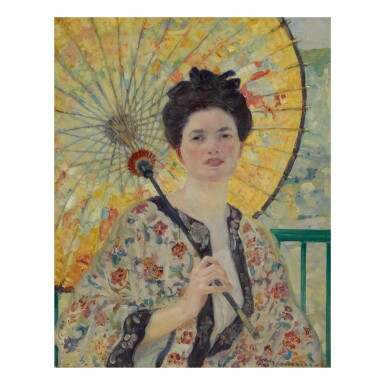
FREDERICK CARL FRIESEKE | JAPANESE PARASOL
Auction Closed
November 19, 04:22 PM GMT
Estimate
250,000 - 350,000 USD
Lot Details
Description
FREDERICK CARL FRIESEKE
1874 - 1939
JAPANESE PARASOL
signed F.C Frieseke- (lower right)
oil on canvas
32 by 25 ½ inches
(81.3 by 64.8 cm)
Painted circa 1913.
This painting will be included in the forthcoming catalogue raisonné of Frieseke's work being complied by Nicholas Kilmer, the artist's grandson, and sponsored by Hollis Taggart Galleries, New York.
[with]Ira Spanierman, New York
[with]Hirschl & Adler Galleries, Inc., New York, 1968
Private collection, California, 1978
Hirschl & Adler Galleries, Inc., 1988
Acquired by the present owner from the above, 1988
Savannah, Georgia, Telfair Academy of Arts and Sciences; New York, Hirschl & Adler Galleries, Inc.; Raleigh, North Carolina, The North Carolina Museum of Art; St. Petersburg, Florida, Museum of Fine Arts; Columbia, South Carolina, Columbia Museum of Art, Frederick Frieseke, 1874-1939, November 1974-June 1975
According to Nicholas Kilmer, the present work was painted circa 1913 when the artist spent the winter with his family in Corsica. It was around this time that the burgeoning Giverny Group of American painters had drawn the attention of art critics back in New York. Henry McBride regarded Frieseke and the work of his peers as “on a par with the older and better-known men [of Impressionism]" (as quoted in David Sellin, Frederick Carl Frieseke: The Evolution of an American Impressionist, Savannah, Georgia, 2001, p. 94). McBride went further in this New York Sun review from 1911 announcing, “He has youth audacity, talent, science, and the shrill of scarlet trumpets of high noon sounds in the majority of his canvases...the refulgent tones of Japanese umbrellas fight for supremacy with the surrounding flowers” (as quoted in Ibid.).
Japanese Parasol shares the same exuberance McBride summarized—the figure’s parasol is articulated in sprawling, sunlight strokes, framing the porcelain female figure laid in a richly decorated floral patterned robe.
